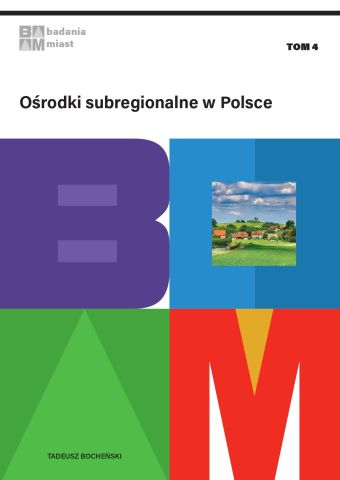
ISBN: 978-83-7972-493-2
ISBN (online): 978-83-7972-804-6
ISSN: 2719-3667
OAI
DOI: 10.18276/978-83-7972-804-6


Issue archive / Tom 4
| Year: | 2021 |
| Field: | Field of Social Sciences |
| Discipline: | social and economic geography and spatial management |
| Authors: |
Tadeusz
Bocheński

Uniwersytet Szczeciński |
Information
Date of release of the digital version under CC-BY-SA licence: August 2024
Issue File
Abstract
Sub-regional centers in Poland
The studies described in this volume were aimed identify sub-regional centers in Poland and to evaluate their socio-economic potential.
In the introduction, reference was made to the polycentric nature of the settlement network and its importance. It was emphasized that Poland is characterized by a highly polycentric settlement network, but centralization is visible, which is in contradiction with the assumptions of the European Union policy. The more and more efficiently functioning polycentric systems are indicated as an important element of balancing development.
The second chapter analyzes the structure of cities, planning documents at various levels (European, national and regional), and several scientific studies containing various types of classifications and typologies of cities in Poland. On this basis, cities were selected for further research. 120 cities were selected as sub-regional centers - both main, supplementary, and potential. The decisive factor in selecting a given city was its indication as a supra-poviat center in at least one planning document (109 cities). Then the list was completed on the basis of the analysis of selected scientific studies. This collection was the subject of research in the following chapters.
Chapter three describes the characteristics and evaluation of the socio-economic development of 120 previously selected cities. The analysis takes into account six groups of factors: demographic potential – population number and its changes; location in relation to other larger urban centers – the so-called peripherality; the role of a given center as a transport node – including internal (urban) and external transport; institutional base in the field of public entities of supra-poviat importance; selected economic conditions, i.e. the level of entrepreneurship development and business environment institutions; development of civil society – non-governmental organizations and turnout in local elections. In recent years, the vast majority of the examined cities recorded a decrease in inhabitants, which in the case of Wałbrzych in the years 2000–2019 exceeded 15%. Only in the 10 analyzed cities did the number of inhabitants increased in the last decade – the most, more than 10%, in Ełk and Wejherowo. Częstochowa was considered the best-developed transport node in the group of cities, while Chełmno and Ustka were the worst. Among the examined cities, former voivodship cities were characterized by a clearly higher level of socio-economic development, and especially with a well-developed institutional base. Częstochowa, Tarnów, Koszalin, Legnica, Suwałki and Bielsko- Biała were ranked the highest. Among the analyzed cities that did not perform voivodship functions in the past, Sanok, Wałcz and Zakopane – due to the development of civil society, and Kędzierzyn-Koźle, Grudziądz, and Starachowice – due to economic development, were the ones that was characterized by the highest above the average level of development.
Chapter four contains an analysis of the connections and the range of influence of selected cities. Functional urban areas according to the ESPON 1.4.3 project, functional urban areas according to the delimitation in the National Spatial Development Concept until 2030, and Ministry of Regional Development delimitation, ITI (Integrated Territorial Investments) associations, and associations of functional areas were taken into account. Potential polycentric subregions as well as agglomerations and urban conurbations created by the studied cities were indicated. Reference was made to the concept of urban regions based on commuting distances and the transport accessibility to potential subregional centers was analyzed. The travel time by car from communal centers and the connection of public transport between the examined cities were taken into account. A proposal for subregion delimitation and a case study was presented, including previous own research on the range of subregions in Pomerania. The analysis shows that most of the examined cities were part of functional urban areas, created independently or with other cities. Assuming 91 sub-regions (sub-regional and voivodeship centers), almost 60% of communal centers in Poland would be within a 30-minute drive to the nearest sub-regional center. The connections by public transport between the examined cities and voivodship centers were diversified. In the case of 4 teams of the examined cities, connections were provided by public transport. On the other hand, the weakest connections were found in Wieluń, Busko-Zdrój, Bełchatów and Słubice.
The presented research fits into the concept of polycentric development of the country – it shows the potential of cities that should provide access to secondary services, including public ones.